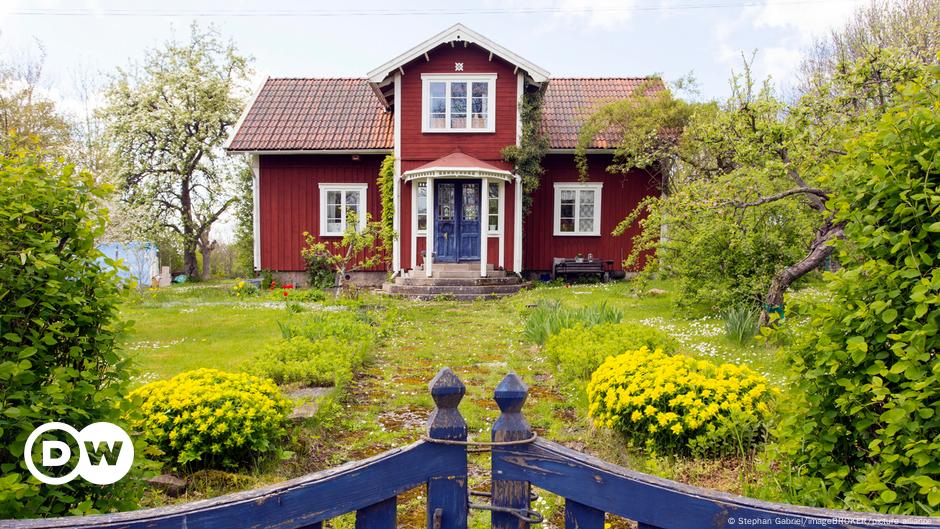Granted, the sober facades of Götene’s large housing blocks have little in common with the classic ideal of the traditional Swedish cottage in red and white. But on the other hand, with land selling at less than 1 krone (about 10 cents) per square meter, prices in the southeastern Swedish town — population 5,000 — make it attractive.
Buyers looking to procure a 150-square-meter (1,615-square-foot) plot, about the size needed to build a single-family home, can currently get one for less than €15 ($16). That extremely cheap price applies to 30 lots abandoned in Götene decades ago.
But no one seems interested in them, even though the town is located near Sweden’s popular Vänern, the largest lake in the European Union.
The town hopes that by selling the plots for so little, it can attract buyers to the region and breathe new life into it. One stipulation, though, is that new owners are required to build a house on the plot within two years.
Even though the lots went on offer so cheap, sales started off sluggish. But then a viral TikTok video and international news coverage by English-language outlets led to a breakthrough, and city administrators were suddenly swamped with inquiries.
“We had prospects from Europe, Asia — mostly India and Pakistan — the US, Australia and even South America,” said Mayor Johann Mansson.
Sales have now been paused, with an eye to putting the municipality’s remaining lots up for auction in early August.
Europe’s rural exodus
The situation in Götene typifies a trend that has been ongoing in Europe for years.
Young people are fleeing towns and villages short on employment opportunities in favor of larger cities, which they find more attractive. That tendency eventually turns into a vicious circle that sees more and more people leaving and infrastructure falling into entropy.
EU programs, initiatives and marketing activities are all designed to end the doom spiral, helping places like Götene before entire rural regions sink into oblivion.
According to experts, the trend of young people gravitating to cities will continue. The European Commission, the EU’s executive branch, predicts urbanization will grow to 83.7% by 2050. Currently, some 74% of EU residents live in cities.
€1 houses in Italy
Those interested in purchasing houses in Italy have been able to get them cheap since at least 2008. Most abandoned houses are auctioned off for prices starting at the symbolic price of €1 and end up selling for just a few thousand.
Some 50 Italian municipalities are currently offering so-called “Casa a un Euro” (€1 houses) in hopes of reanimating their dwindling villages. Most of these run-down fixer-uppers can be found in Tuscany, Apulia or on the island of Sicily.
However, purchasers must enter an agreement with the municipalities in which they commit to restoring the homes they buy. Some villages even require purchasers to reside in the homes themselves and sign agreements that they will not rent them out as vacation homes. Since many of these structures are in a state of serious disrepair, restoration costs can be extremely steep.
Those who are not intimidated by such prospects can readily find deals on commercial websites, those of the municipalities or via local initiatives. “StreetTo,” for instance, describes itself as a collective of young people who want to revitalize the historic city center of Cammarata in Sicily. On their website, the collective says they are looking for people who will actively participate in bringing “new vibes and ideas” to the old alleys of the ancient town.
Dirt cheap prices on the German countryside
In Germany, rural stretches of central and eastern Germany have witnessed severe depopulation since reunification in 1990, whereas its cities have continued to grow during that same time. Over the past few years, however, that trend seems to have stopped.
According to a September 2023 study by the Berlin Institute for Population and Development, people between the ages of 30 and 49 are behind the new dynamic, preferring to pack up their kids and leave the city in favor of rural living. The turnaround appears to have been given new impetus by the COVID-19 pandemic and the possibilities of remote work that it ushered in.
But despite the reversal, it is still possible to find deals in the German countryside. Sure, there are no German equivalents to Italy’s €1 houses or Sweden’s cheap plots, but online commercial sites like ImmoScout24 still regularly feature homes for just a few thousand euros — like one currently listed for auction in Wurzen, Saxony, for a starting price of €6,200, or another in Bobritzsch, Saxony, starting at €9,200.
Still, other prospective buyers are interested in snapping up houses and property for even less—namely for free. Such properties are available because the previous owners have simply given them up without being able to sell them. According to the state’s Finance Ministry (as of 2020), there are roughly 1,200 such abandoned properties in the western German state of Rhineland-Palatinate.
However, potential buyers should think twice before taking the plunge, as seemingly “free” properties are not always that. Even though a property is abandoned, it may be under lien by municipalities or banks — just because the owner has disappeared that doesn’t mean a mortgage has, these simply get transferred to the next owner.
This article was originally published in German and was translated by Jon Shelton.

